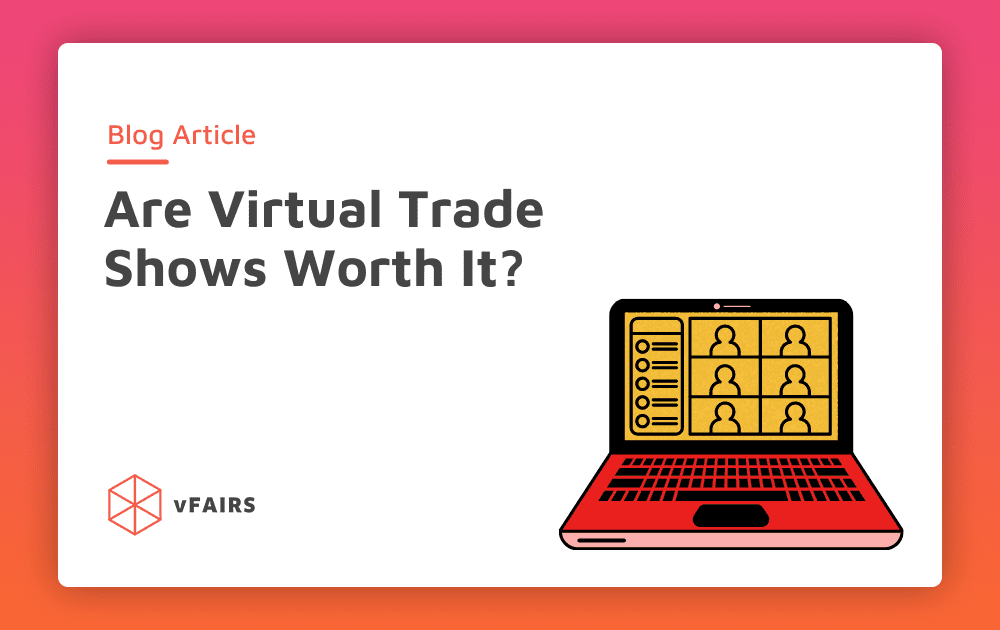While virtual trade shows, among other types of virtual events, have seen a surge in popularity recently — due in most part to the COVID-19 pandemic — they have actually been around for a lot longer.
Mostly, companies have found success incorporating them in their marketing strategies, but there have been scenarios where the results were not all too great. So, are virtual trade shows worth it?
The focus of this article is to make sure you understand whether or not trade shows are worth your efforts by looking at what they’re essentially used for, their benefits, and their drawbacks.
The Idea Behind Virtual Trade Shows
The idea behind virtual trade shows is that the hosts, attendees, and exhibitors, all get to partake in the event as they would in a normal, physical trade show by emulating all its aspects over the internet. This is done through 3D virtual auditoriums, exhibition halls, customized booths for companies, and more.
But how does it actually compare with the real deal? While the emulation is there, does it really capture that experience? The answer is… well, it’s a mixed bag.
Some people find that virtual trade show platforms are definitely the future, as they allow for a lot of convenience and ease, reduce costs, and even help the environment by allowing for reduction of paperwork as well as carbon footprint caused by traveling.
However, the detractors point that they don’t provide enough audience engagement, and the experience doesn’t stand up to the expected standards.
Let’s do an in-depth analysis…
Benefits of a Virtual Trade Show
Inclusivity and Reach
The first, and almost obvious, benefit you can get is inclusivity and reach. With virtual trade shows, it’s possible for almost anyone to attend as long as they have an internet connection. This gives you the opportunity to reach out to more people than you normally would. Companies that are interested in exhibiting at your event would also find it attractive.
To support this point, here’s what a G2 reviewer had to say:
“The upside of using vFairs is the extended reach that allows for meetings to increase participation.”
Diversity
Participants at a virtual trade show are able to interact with people from different backgrounds. It allows for diversity in networking that wouldn’t be possible in an in-person setting. Companies can also expand and reach a diverse audience, learn more, and find collaborators in places they wouldn’t have thought of before.

Cost-effective
Next, it’s cost-effective. All costs related to the physical space are drastically reduced, from the traveling costs of the participants to costs pertaining to venue and booth arrangements. Cleaning, booth design, accommodations, printing… all costs are either inapplicable or at least cut down significantly.
Eco-friendly
It’s also eco-friendly. In fact, this is one of the reasons people are moving towards virtual events. Because the participants aren’t required to travel, it can cut down significantly on greenhouse gas emissions, which helps limit climate change as each individual’s carbon footprint is reduced. Since it’s all online, there won’t be much paperwork involved either, hence cutting down on the use of paper.
Event Analytics
One of the most sought-after features of a virtual trade show is the event analytics. You can understand audience behavior, preferences, and interaction much better than you could with a live show. Because there will be a record of almost every action performed by every participant, you can ask a number of questions and get answers from the data collected. For example, “which booth had attracted the most audience?”, “how long did people stay in the event for?”, and more.
Shortcomings of a Virtual Trade Show
One of the main reservations against virtual trade shows will always be brought up: the experience. Some still fear that virtual trade shows may not capture the experience of a physical trade show. However, the general perspective towards this is changing with time and the ever-advancing features of virtual event platforms.
You might also want to keep in mind that not all of your participants will have stable internet connections and that they can always break, interrupting live chat. You might want to mention this in your emails so the participants are already prepared.
Time zone constraints may be problematic, so don’t be alarmed if a number of people are unable to attend the event. For that, it’s always a great idea to have recorded sessions uploaded on the event website.
Lastly, the attendees may not be skilled when it comes to using virtual events tools. Great virtual event platforms will be built around user experience. So attendees, no matter how tech savvy, should be able to easily navigate the platform. This should be kept in mind.

How to Make the Most Of Your Trade Show
To make your event worth it, you will need to a) promote it extensively, and b) make it as engaging as possible.
Virtual trade shows can be marketed and promoted similar to their live counterparts. But since the target audience usually comes from a diverse locality, the focus is online marketing. But again, the principles followed are the same.
First and foremost, you will need a list of people. You can gain a following through different means such as blogging and email marketing. A solid online reputation and credibility are also essential for maximum ROI. Once you have got the leads (list of people), you can send them invitation emails for your event.
Next, you will need a landing page so your invitees can easily register. The landing page will serve as the first impression for your event, so special focus needs to be given to the design and copy.
The next steps usually involve reminder emails to keep the invitees engaged to ensure they don’t forget to attend the event.
To improve engagement, you can make sure the chat features work on the platform being used, and that the interaction is as seamless as possible between all types of environments. You could also look into gamification for your trade shows, it can significantly improve and encourage attendee engagement.

Are Virtual Trade Shows Worth It?: Takeaways
We’ve looked at what exactly virtual events and trade shows essentially are along with their benefits and drawbacks. In most ways, they’re going to be beneficial as long as all participants attend with an open mind.


